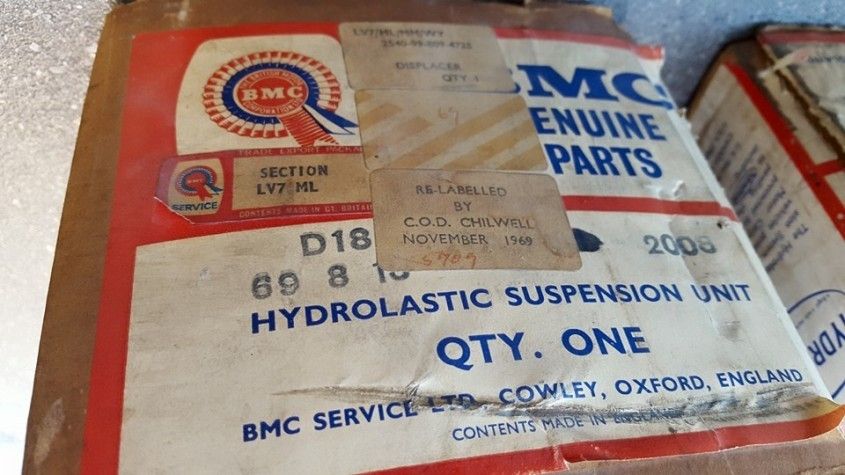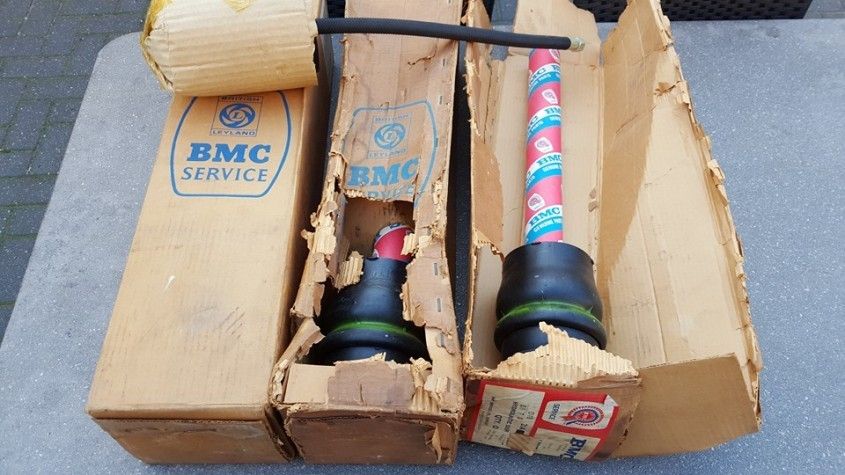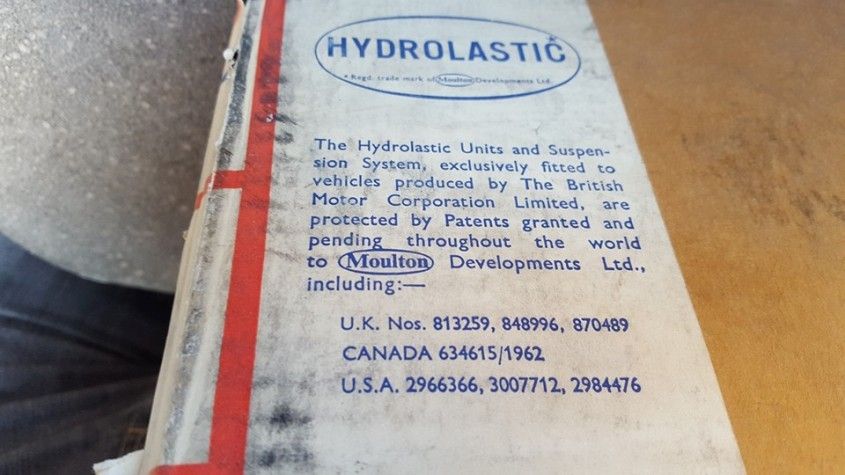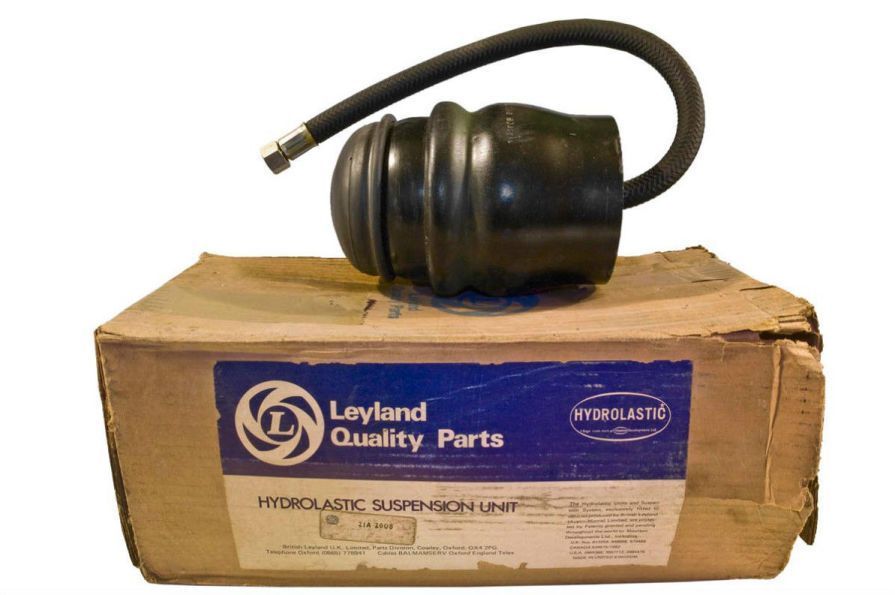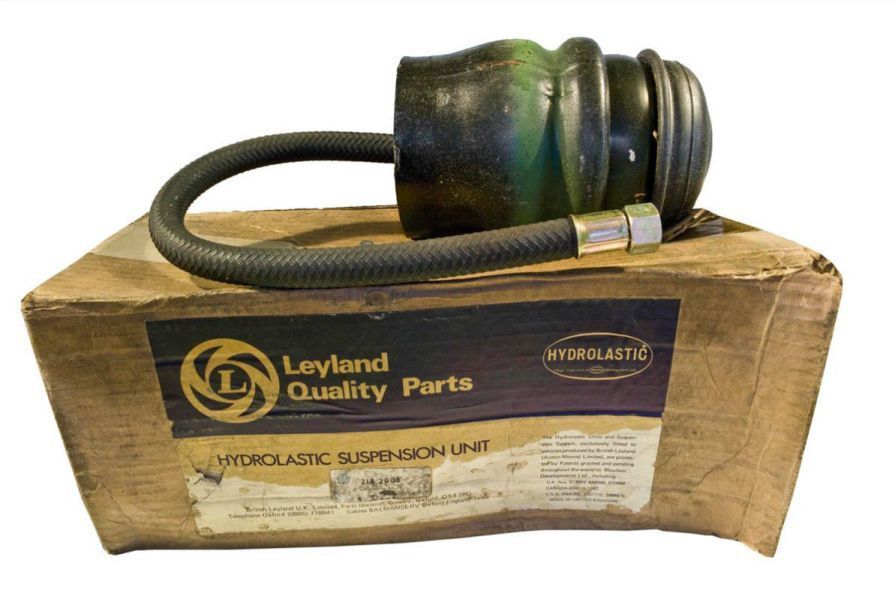Page 3 of 3
Re: Identifying Hydro Units
Posted: Sun Jul 12, 2015 10:07 pm
by InimiaD
Thanks Nev. That solves some of the numbers out.
I unearthed another pair of hydro units today and for the life of me, I can't remember what car they came from.
So, armed with a rotary wire brush and a drill I started cleaning the crap off them not expecting to find any clear markings.
On one of them, clear as day, was the code 21A 1804 66. (66, build date of hydro unit.)
This code tallies with the index chart in the tech section which shows that the above hydro unit is / was the same for S's Coopers and all Mini's etc of 1966 vintage.
The hydro unit also has the rubber further down from the top edge.
Re: Identifying Hydro Units
Posted: Fri Jul 17, 2015 10:55 am
by IslandBlue
Like others I've always been impressed by the durability of these units (cue sagging car next time I open the garage door).
I'm not a hydraulic engineer but if the S units perform differently on the car then presumably there's some sort of hydraulic shock/load test that would show this on the bench?
Also has anyone experienced odd handling following replacing a unit that could be put down to the replacement unit being of a different spec as opposed to just defective?
Fascinating thread all the same.

Re: Identifying Hydro Units
Posted: Fri Jul 17, 2015 12:05 pm
by Dr S
Anyone have any idea whats going on with these two units?
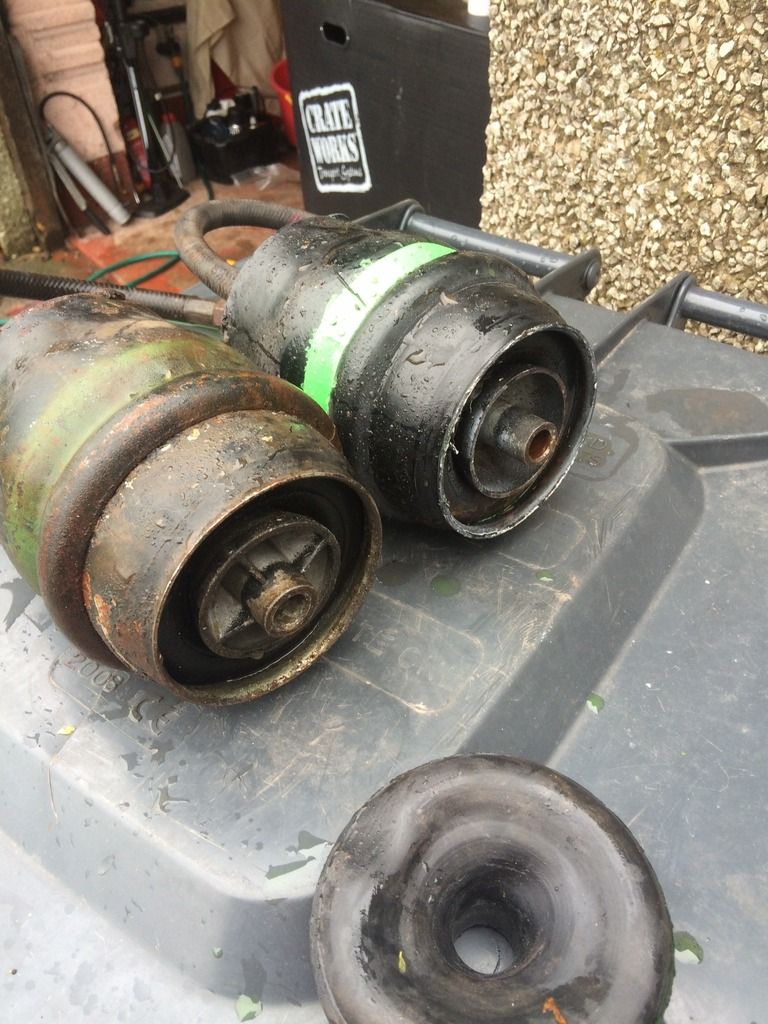
One has quite a different support for the knuckle, its also physically a bit smaller..
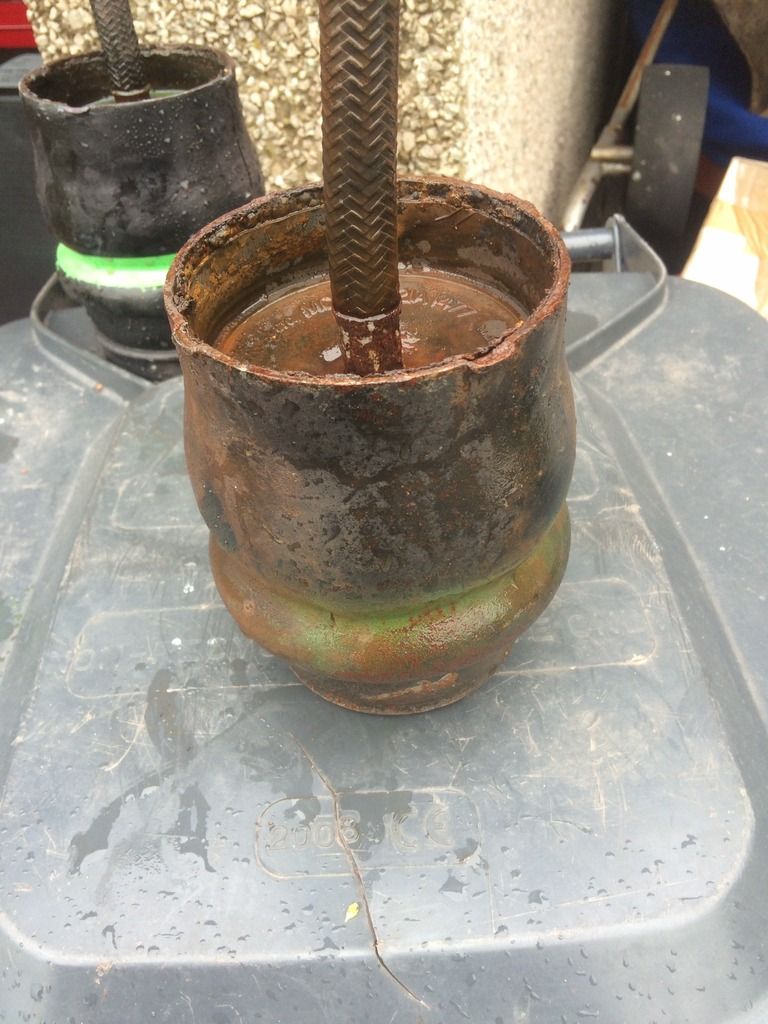
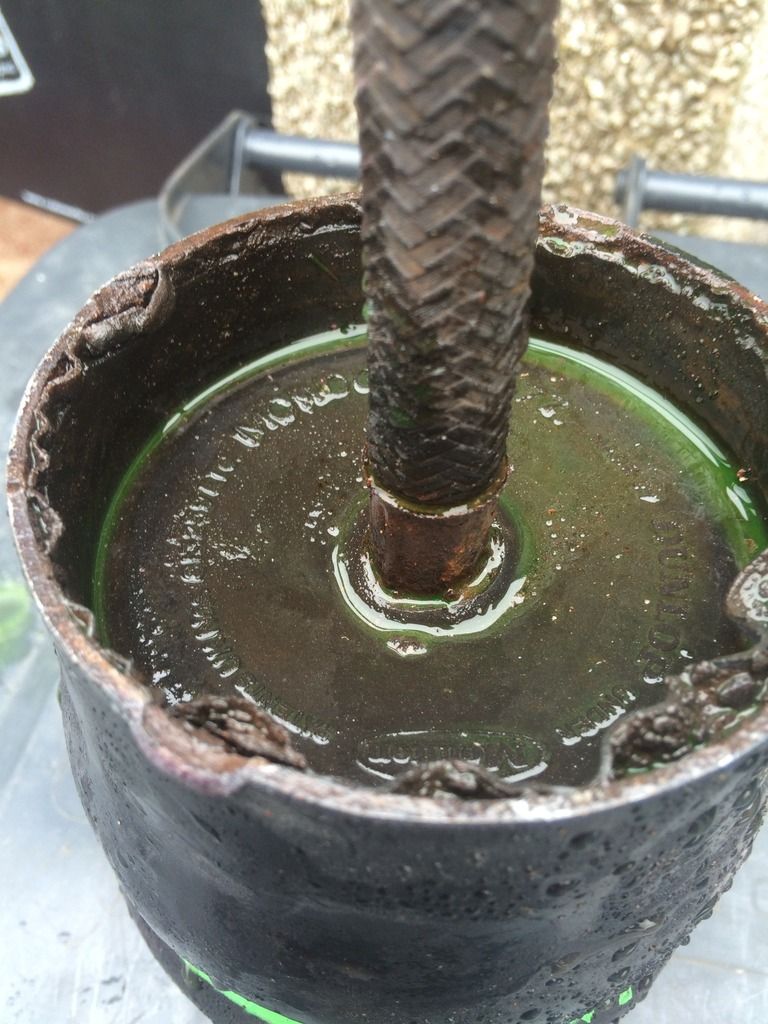
Re: Identifying Hydro Units
Posted: Fri Jul 17, 2015 1:11 pm
by Tim Harber
Ally knuckle bit = late UK produced 21A2008 only, as far as I'm concerned
The rubber dust gaiter was shorter on the small inner part as it couldn't slide down as far as steel version. Cut down current spec one to fit properly
There are two lengths of stub of the steel knuckle joint adaptor and I haven't worked out which is when and how
Green paint was always a token dusting of green identifying paint, not quite as energetic as the RH unit
Re: Identifying Hydro Units
Posted: Fri Jul 17, 2015 1:33 pm
by Dr S
Cheers Tim, looks like I might have a mismatched set on the car the moment then.
Do you have an S one to section like the other one? I'd be fascinated to see in it, I've got a really rough late one that could be sectioned as well for the good of understanding.. is it just an hour with a hack saw?
Re: Identifying Hydro Units
Posted: Mon Jul 20, 2015 10:01 am
by mab01uk
abri wrote:Surely there must be some people who have stripped down unmolested S'es and taken note of the part numbers stamped into them.
I have one restored CKD (in South Africa) '67 S that has orange band displacers on it...whether these came from the factory I can't say for sure. I have been told by someone who worked at BMC/Leyland here at Blackheath that they used standard displacers on the S but fitted a little reducer in the pipe to make it stiffer. My other car, same age, has unmolested suspension but I've never had it apart and can't see any coloured paint or part numbers on its displacers.
I am currently reading the interesting book "The Story of the BMC 1100" (I recommend it to Mini enthusiasts) which has a large section devoted to the detailed development of hydrolastic......see quote below from Alex Moulton writing an in-depth article on Hydrolastic for the 'Automobile Engineer' in 1962:-
"Because of the interconnection of the front and rear springs, the dynamic loads on any one wheel are shared by both, the actual proportions distributed between the two being determined by the throttling action of the conduit. Full wheel movement, therefore , is not normally accompanied by full spring movement, and a relatively soft ride is produced. At higher road speeds the resistance increases , as the cube of the fluid velocity, and this steadies the car in the pitch mode. The effective diameter of the conduit is critical. On the Morris 1100, the conduits are of larger bore than is necessary, but each incorporates an orifice plate which determines the ride characteristics."
"
The Story of the BMC 1100"
http://www.the1100club.com/bookdetails.php
The tooling and manufacturing process required for the robust Hydrolastic units produced in their millions must have been amazing and unique in engineering terms, does anyone have any details or photos of the factory process?....so sad that it all seems to have been scrapped with no trace. The technical development and materials used in the displacers are also the result of many years of detailed testing and research, easy to forget but detailed well in the above mentioned book.
Re: Identifying Hydro Units
Posted: Tue Jul 21, 2015 6:19 pm
by Tim Harber
Dr S wrote:Cheers Tim, looks like I might have a mismatched set on the car the moment then.
Do you have an S one to section like the other one? I'd be fascinated to see in it, I've got a really rough late one that could be sectioned as well for the good of understanding.. is it just an hour with a hack saw?
The units should be OK to go as a pair - just the socket different
The S one that I cut up is subtly different to the other one I have cut (yes, hacksaw, grunt) but has now left us puzzling why there should be the differences in design
It was a 21A2014 - rear mid to late age S, so if anyone has any other S units that are dead , you can volunteer them for inspection
Re: Identifying Hydro Units
Posted: Thu Aug 27, 2015 10:27 am
by Spider
mk1 wrote:I am staggered that there hasn't been more definitive comment on this subject. I can only assume that there is one of two possible conclusions to draw.
1) No one knows if early (64 - 66) Hydro units fitted to Cooper S's were the same as Standard ones.
or
2) Those folks who do know are keeping quiet, because they don't want everyone to know this is the case.
If anyone who knows anything can shed any more light on this subject, I for one would be very interested to read what you have to contribute.
Mark F
I came across this bit of factory info re Cooper S and it would seem that the earliest of them had standard hyro units along with the rest of the range
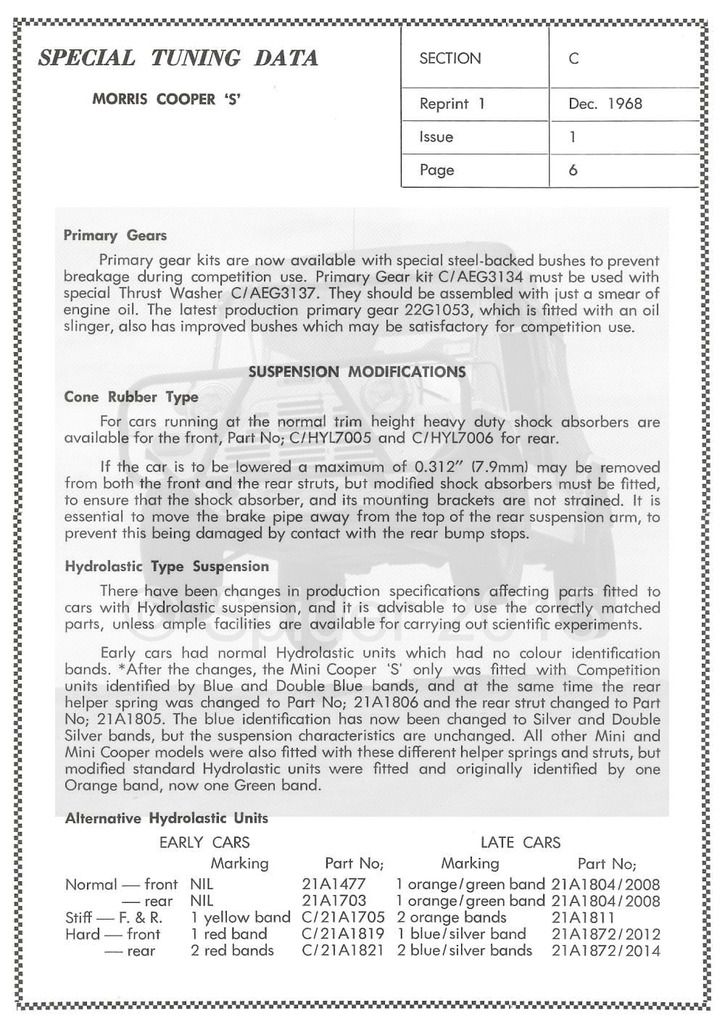
(The * only makes a reference to look back to the parts book for the various change points)
Re: Identifying Hydro Units
Posted: Thu Aug 27, 2015 10:47 am
by mk1
BUGGER!
Thats an extract from the Aussie ST parts list. I have one of those

I guess I should have read it more closely.
M
Re: Identifying Hydro Units
Posted: Thu Aug 27, 2015 11:03 am
by Spider
Bhahaha,,, there you go.
Mark, I would guess my own library to be less than half your and I struggle something horrible to keep on top of what's there. It's usually only when looking for 'G' that I find 'B'.
I also have a UK listing on the Hydro Displacers, the info is in there with the change points (and car numbers) but it really does my head in something awful every time I pick it up, it's much like a mad women's shit - all over the place!
Re: Identifying Hydro Units
Posted: Thu Aug 27, 2015 11:24 am
by mk1
it really does my head in something awful every time I pick it up,
Ha, ha. . . I know that feeling

Re: Identifying Hydro Units
Posted: Fri Aug 28, 2015 1:31 pm
by R&R
I have a couple of sets of silvers, and a pair of blue displacers, one set of silvers is still on my GT, and the other set are from a Mk3 S, nearly all have their relevant part numbers stamped in, where still visible. I also have several standard displacers, and it seems the shape of the appearance of the rubber in the top is different, the standards are flatter, the S types having a more hemispherical shape.
Re: Identifying Hydro Units
Posted: Sun Oct 11, 2015 1:41 pm
by Pete
Re: Identifying Hydro Units
Posted: Sun Oct 11, 2015 4:11 pm
by Nick W
Bet they don't get fitted as you'll never find any more NOS ones
Are they yours
Re: Identifying Hydro Units
Posted: Sun Oct 11, 2015 4:31 pm
by STG95F
Re: Identifying Hydro Units
Posted: Sun Oct 11, 2015 9:30 pm
by wolseley 1000
Re: Identifying Hydro Units
Posted: Sun Oct 11, 2015 10:48 pm
by JC T ONE
Nick W wrote:
Bet they don't get fitted as you'll never find any more NOS ones
They will be fitted, it was a guy on FB that got these 4 off his Father.
Re: Identifying Hydro Units
Posted: Mon Oct 12, 2015 12:44 am
by Pete
Re: Identifying Hydro Units
Posted: Mon Oct 12, 2015 2:45 am
by Highnumbers
Great timing for this topic, just this afternoon I disassembled both subframes of my barn fresh '66 Cooper S and removed all four hydrostatic displacers.
Now throughout the car I can't find any indication that it's ever been taken apart, particularly the suspension/subframes. Even the factory markings were present.
I was pleased to find blue band 21A1872 displacers in the front and 21A1874 blue band in the rear. All four of which should be correct for the car, according to this thread?
Fingers crossed, but the car sat well on the displacers and drive fine with no leaks. Hoping they will not need to be replaced!




